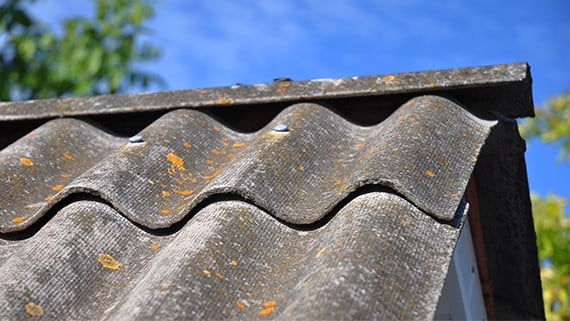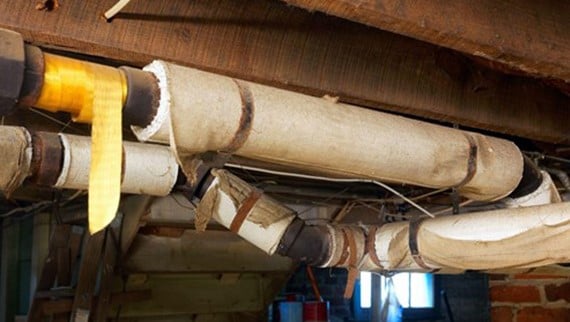How to recognise asbestos
8 minute read

Asbestos used to be a widely used material in homes across the UK before people began to realise the health implications associated with the material. Whether you want to learn more about this material or identify it in your home, keep reading our guide.

Over 50s Home Insurance
Age Co helps you protect the things you love. We’re 100% owned by Age UK and our profits go back to the charity.
The use of asbestos in construction has been banned in the UK since 1999 and shouldn't have been used in any houses built after this time. Although, as it was so widely used prior to this, it still exists within the fabric of many structures today - from residential homes to public buildings.
You may be reading this article because you’ve found what might be asbestos in your home or a house survey has identified the substance. If so, below are some key things to bear in mind when trying to identify asbestos.
How many common types of asbestos are there?
There are six different types of asbestos, the three most common of which are more often referred to as white, brown and blue:
- Chrysotile (white)
- Amosite (brown)
- Crocidolite (blue)
- Anthophyllite
- Tremolite
- Actinolite
Chrysotile (white) is the most common type in the UK because of its fire and heat resistant properties. It can be found mainly in roofs, ceilings, floors and insulation in buildings, but was also used in some cars. Older textured wallpapers and decorative surfaces, including Artex, may also contain this type of asbestos.
Amosite (brown) asbestos is the second most common and can mainly be found in pipe insulation and cement sheets. This means it’s generally hidden behind walls, which is good news, as you're less likely to be exposed to the dangers it can pose when it's embedded behind or within something.
Crocidolite (blue) asbestos is known to be the most dangerous type of asbestos because the fibres are thinner and more easily inhaled and lodged into the lining of the lungs. It was widely used in commercial properties, pipe insulation and many other cement products.
The remaining three types are less common but could still be found in insulation and other construction materials.
How to identify asbestos
If you think you may have found asbestos in your home it’s important to identify it so that you can take the appropriate next steps. The material has been linked to pleural disease, mesothelioma and lung cancer. However, these things generally only occur when the broken fibres of the material are breathed in over a long period of time. If you have asbestos flooring in your kitchen, for instance, it’s likely not a danger if it’s undamaged and in one piece.
Generally, people only uncover asbestos when they begin to renovate their home. Below are some things to look out for, but if you're in any doubt it may be worth seeking professional advice.
What does asbestos look like?
Asbestos can be difficult to identify, as it may look different depending on the application it’s been used for.
Below is an example of asbestos and cement used together to create corrugated roofing on a garage. When these two materials are combined, they create a very strong, fire-resistant structure, which is why it was so popular for roofing and other structural elements of buildings.

To determine whether this is asbestos or not, a sample would likely need to be taken and sent off to a lab for analysis.
It can be hard to see the individual fibres when the asbestos is in one piece, but below is what it looks like when it’s broken apart. This is when the material is at its most dangerous because you’re at risk of breathing in the tiny particles.
If you can spot the fibres, you should vacate the area immediately and call an expert to analyse the material. We describe who to contact later in this article.

The image above is of blue asbestos, or Crocidolite, the third most common type of asbestos.
Asbestos has also commonly been used as floor tiles in the past, which may look a little like the below:

What does asbestos insulation look like?
Asbestos was used in lots of different types of insulation, from block and spray-on insulation to loose-fill and preformed insulation. For this reason, it won’t always look the same or take the same shape.
Below is an example of loose-fill insulation that contains asbestos. When it’s contained within the wall, it’s not harmful, but when it spills out as below, you’re at risk of breathing in the fibres.

As we’ve already mentioned, asbestos insulation can also surround pipes, like below.

Who to contact if you find asbestos at home
If you think you’ve uncovered asbestos, you should stop what you’re doing immediately and visit the government website. Here, you can enter your postcode and be redirected to your local council. The council will likely inspect the property to confirm whether the material is asbestos or not. If it is, they will arrange for professional removal.
Remember: you should always seek professional assistance if you suspect your home may contain asbestos.
Summary
Because of the health implications involved, if you suspect asbestos is present in your home, keep these points in mind:
- Asbestos can feasibly be present in any home that was built or refurbished before the 1999 construction ban came into effect.
- It is typically found in insulation, roofing materials, in flooring, and around pipes.
- When intact, the material is unlikely to pose a risk to your health – only when damaged or broken up is it deemed dangerous.
- Because asbestos looks different depending on the application it’s been used for, it can be difficult to identify and requires lab testing to be confirmed.
- If you think you’ve uncovered asbestos, you should stop what you’re doing immediately and use the government website to enlist the help of your local council.

Sign up to the Age Co Newsletter
Each month, our email newsletter delivers inspiring stories, practical guides to later life, plus the latest news about Age Co and the charitable work we support.
